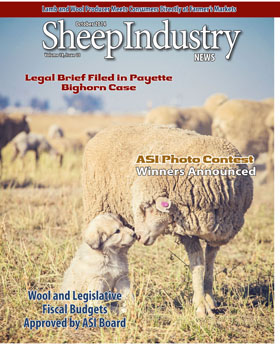
- October 2014
- President’s Notes
- ASI Team Represents Industry in Nanjing
- Belt Buckle Commemorates ASI’s 150th Anniversary
- Colorado Youngster Constructs Lego Camp in Honor of Family Heritage
- Commentary: Recent Headlines Are Example of Public’s Misunderstanding of Protection Dogs
- Dan Wilson: The Best Lamb Marketer is Usually the Person Who Raised the Lamb
- Grazing Allotments, Bighorns Take the Stage at Public Lands Council Meeting
- Market Report
- Nomination Deadline for Annual ASI Awards: Nov. 15
- Opening Brief Focused on Forest Service Payette Errors
- Sheep Budgets for 2014 Approved by Board
- Sheep News in Brief
- Working Together to Make Sheep Better
Opening Brief Focused on Forest Service Payette Errors
WASHINGTON — An Opening Brief on behalf of the Idaho Wool Growers Association in the Payette Forest/bighorn sheep case has been filed by the law firm of Holland and Hart.
According to the brief, which requests that the court vacate the Final Supplemental Environmental Impact Statement (SEIS) and Record of Decision, the district court made three legal errors in approving the National Environmental Policy Act (NEPA) procedures. The court also applied the wrong standard of review to the wool growers claim that the Forest Service failed to obtain the special expertise of the U.S. Department of Agriculture’s Agricultural Research Service (ARS).
ASI has joined Idaho in the case, along with the Public Lands Council, Colorado Wool Growers Association, Wyoming Wool Growers Association, Shirts Brothers Sheep and Carlson Company, Inc.
The core of the suit can be categorized into three parts. First, the Forest Service failed to comport with the plain meaning of NEPA and its implementing regulations that required it to obtain ARS’s special expertise on the merits of the SEIS. This requirement is at the heart of NEPA. It compels the lead agency to consider other agencies’ special expertise and in so doing, improve the Draft NEPA analysis before it is finalized and presented to the public. No deference is owed to the Forest Service’s interpretation of NEPA or its implementing regulations because the statute and regulations are unambiguous and the regulations are those of the Council on Environmental Quality, not the Forest Service.
Second, the Forest Service erred in failing to supplement its Final SEIS with significant information showing that the Forest Service had incorrectly interpreted the Lawrence study.
Third, the Forest Service failed to consider important aspects of its predictive models. One model predicted a risk of contact between domestic sheep and bighorn sheep without uniformly considering physical barriers to sheep mobility that would have affected the likelihood of contact. Another model predicted disease outbreaks following contact between the species while ignoring information in its own files showing that during significant portions of the year, the species were not on the national forest allotments at the same time. That model also failed to consider the lifecycle of disease transmission and the effect of the passage of time on the probability of a disease outbreak.
These failures show a pattern of Forest Service errors and omissions that could have been avoided had it taken the time necessary to conduct “a transparent process done correctly” as instructed in previous litigation.
Had the Forest Service obtained the special expertise of ARS, it would have both complied with its clear duty under NEPA and acquired the additional information it needed to conduct a supplemental analysis of the Lawrence study. The Forest Service would have also adequately considered key information that was omitted from its new models. The entire Opening Brief is available at www.sheepusa.org.

